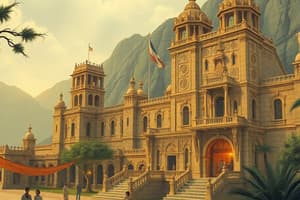Podcast
Questions and Answers
¿Cuál es el nombre del paso más alto en el Camino Inca?
¿Cuál es el nombre del paso más alto en el Camino Inca?
¿Cuál fue el propósito principal del Camino Inca en la época del Imperio Inca?
¿Cuál fue el propósito principal del Camino Inca en la época del Imperio Inca?
¿Cuál es el propósito principal de la regulación del Camino Inca?
¿Cuál es el propósito principal de la regulación del Camino Inca?
¿Qué tipo de sociedad caracterizaba a la civilización inca?
¿Qué tipo de sociedad caracterizaba a la civilización inca?
Signup and view all the answers
¿Cuál es el nombre del sitio arqueológico donde los senderistas tienen su primera vista de Machu Picchu?
¿Cuál es el nombre del sitio arqueológico donde los senderistas tienen su primera vista de Machu Picchu?
Signup and view all the answers
¿Cuál fue el papel del Camino Inca en la economía del Imperio Inca?
¿Cuál fue el papel del Camino Inca en la economía del Imperio Inca?
Signup and view all the answers
¿Cuál es el nombre del sistema de carreteras que incluye el Camino Inca?
¿Cuál es el nombre del sistema de carreteras que incluye el Camino Inca?
Signup and view all the answers
¿Cuál es el título que se le otorga a Machu Picchu?
¿Cuál es el título que se le otorga a Machu Picchu?
Signup and view all the answers
¿Qué tipo de tecnología avanzada caracterizaba a la sociedad inca?
¿Qué tipo de tecnología avanzada caracterizaba a la sociedad inca?
Signup and view all the answers
¿Cuál es la función del permiso requerido para caminar el Camino Inca?
¿Cuál es la función del permiso requerido para caminar el Camino Inca?
Signup and view all the answers
¿Cuál fue el propósito de la aristocracia en la sociedad inca?
¿Cuál fue el propósito de la aristocracia en la sociedad inca?
Signup and view all the answers
¿Cuál fue el material principal utilizado en la construcción de viviendas en la sociedad inca?
¿Cuál fue el material principal utilizado en la construcción de viviendas en la sociedad inca?
Signup and view all the answers
Study Notes
Peru
Peru, located in South America, boasts a rich history and diverse culture. One of its most notable aspects is the Inca Trail, a part of the Inca Empire that thrived from the 13th to the 16th century. Let's delve deeper into the Inca Trail, which offers a glimpse into the Inca civilization's history, society, and achievements.
History
The Inca Empire, also known as the Inca Road System, was a vast network of roads that connected different regions of the empire. The Inca Trail is part of this system, stretching across the Andes Mountains in Peru. This trail was a crucial aspect of the Inca Empire's infrastructure, facilitating trade, communication, and military movement.
Society
The Inca civilization was known for its highly stratified society. The emperor ruled with the aid of an aristocratic bureaucracy, exercising authority with harsh and often repressive controls. Despite this, the Inca society was also known for its advanced technology and architecture, which can still be seen throughout the Andes. Their irrigation systems, palaces, temples, and fortifications are a testament to their engineering prowess.
The economy was based on agriculture, with crops like corn (maize), white and sweet potatoes, squash, tomatoes, peanuts, chili peppers, coca, cassava, and cotton being staples. They also raised animals like guinea pigs, ducks, llamas, alpacas, and dogs. Clothing was made from llama wool and cotton, and houses were constructed from stone or adobe mud.
Religion
The Inca religion combined features of animism, fetishism, and the worship of nature gods. The pantheon was headed by Inti, the sun god, and included also Viracocha, a creator god and culture hero, and Apu Illapu, the rain god. Under the empire, the Inca religion was a highly organized state religion, but it tolerated the worship of native religions. However, during the Spanish conquest, the Spanish conquistadors destroyed these religious institutions as part of their campaign against idolatry.
Inca Trail
The Inca Trail, a part of this vast road system, is one of the most famous treks in the world. It leads to Machu Picchu, a UNESCO World Heritage Site and one of the Seven Wonders of the Modern World. The trail is steep, challenging, and rewarding, offering breathtaking views of the Andes Mountains and the lush, green landscape.
The Inca Trail is also home to many archaeological sites and ruins, each with its own story to tell about the Inca civilization. One such site is the Dead Woman's Pass, the highest point on the trail, which offers a panoramic view of the surrounding mountains. Another site is the Sun Gate, where hikers are greeted by the first view of Machu Picchu.
Today, the Inca Trail is a popular tourist attraction, drawing thousands of hikers from around the world every year. It requires a permit and is strictly regulated to preserve the trail and the environment.
In conclusion, the Inca Trail is a testament to the ingenuity and engineering prowess of the Inca civilization. It offers a glimpse into their history, society, and achievements, and is a must-visit for anyone interested in South American history and culture.
Studying That Suits You
Use AI to generate personalized quizzes and flashcards to suit your learning preferences.
Description
Explora la rica historia y diversa cultura del Imperio Inca en Perú, desde el Camino Inca hasta la sociedad, religión y logros de esta civilización antigua. ¡Averigua más sobre este fascinante capítulo de la historia de América del Sur!




